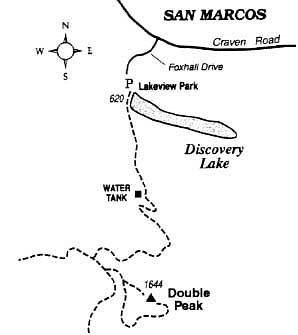 Facebook
Facebook
 X
X
 Instagram
Instagram
 TikTok
TikTok
 Youtube
Youtube
South of the spreading suburbs of San Marcos, a scruffy ridgeline scrapes the southern sky. Topographic maps note the obscure names of its various high points: Cerro de las Posas, Double Peak, Franks Peak, and Mount Whitney (not that Whitney, but still the highest of the group). Double Peak lies within a future 200-acre City of San Marcos regional/interpretive park atop the ridge. Already there's public access to Double Peak by way of old fire roads and newly cut trails. Travel is permitted by foot, horse, and mountain bike.
The five-mile (or somewhat less with a shortcut) round-trip trek to the peak begins at Lakeview Park at the end of Foxhall Drive in south San Marcos, about a mile west of the CSU-San Marcos campus. Start by crossing the dam of bantam-size Discovery Lake, and labor upward on a paved, traffic-free access road that goes 0.7 mile to a large, hillside water tank. Continue your ascent on the rough dirt road to the left, zigzagging upward through chaparral vegetation quickly recovering from the October 1996 Harmony Grove fire.
At the next trail intersection (1.2 miles from the start), turn sharply right and continue climbing more moderately to a wide fire road (1.6 miles total) atop the ridge. Make a left there (going southeast), dip slightly to cross a saddle, and start climbing again. Stay left at the next fork in the fire road. Double Peak, fringed with a clump of trees, lies ahead. Either stay with the fire road, which curls around the south side of the peak and gradually approaches the peak from the back (east) side, or grunt and groan up the steep west-side shortcut route.
A messy old homesite lies atop the Double Peak summit, along with scattered eucalyptus and olive trees, and other surviving decorative landscaping. On clear winter days, let your eyes feast on the view, which stretches from the highest mountain ranges of Southern California (San Gabriels, San Bernardinos, San Jacintos) in the north to the shining Pacific Ocean in the west and southwest.
Those interested in a navigational treasure hunt in the Double Peak area might want to visit the Internet site www.geocaching.com. You'll need a global positioning system (GPS) device to successfully find the hidden "cache."


South of the spreading suburbs of San Marcos, a scruffy ridgeline scrapes the southern sky. Topographic maps note the obscure names of its various high points: Cerro de las Posas, Double Peak, Franks Peak, and Mount Whitney (not that Whitney, but still the highest of the group). Double Peak lies within a future 200-acre City of San Marcos regional/interpretive park atop the ridge. Already there's public access to Double Peak by way of old fire roads and newly cut trails. Travel is permitted by foot, horse, and mountain bike.
The five-mile (or somewhat less with a shortcut) round-trip trek to the peak begins at Lakeview Park at the end of Foxhall Drive in south San Marcos, about a mile west of the CSU-San Marcos campus. Start by crossing the dam of bantam-size Discovery Lake, and labor upward on a paved, traffic-free access road that goes 0.7 mile to a large, hillside water tank. Continue your ascent on the rough dirt road to the left, zigzagging upward through chaparral vegetation quickly recovering from the October 1996 Harmony Grove fire.
At the next trail intersection (1.2 miles from the start), turn sharply right and continue climbing more moderately to a wide fire road (1.6 miles total) atop the ridge. Make a left there (going southeast), dip slightly to cross a saddle, and start climbing again. Stay left at the next fork in the fire road. Double Peak, fringed with a clump of trees, lies ahead. Either stay with the fire road, which curls around the south side of the peak and gradually approaches the peak from the back (east) side, or grunt and groan up the steep west-side shortcut route.
A messy old homesite lies atop the Double Peak summit, along with scattered eucalyptus and olive trees, and other surviving decorative landscaping. On clear winter days, let your eyes feast on the view, which stretches from the highest mountain ranges of Southern California (San Gabriels, San Bernardinos, San Jacintos) in the north to the shining Pacific Ocean in the west and southwest.
Those interested in a navigational treasure hunt in the Double Peak area might want to visit the Internet site www.geocaching.com. You'll need a global positioning system (GPS) device to successfully find the hidden "cache."
